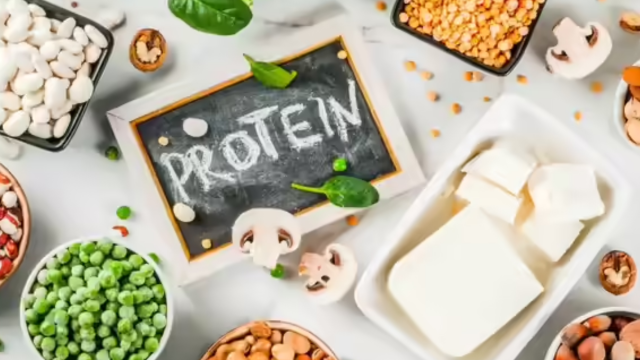November 3, 2025 : In a world where fitness and nutrition are gaining increasing importance, achieving the recommended daily protein intake has become a key focus for health-conscious individuals. A leading Goa-based fitness coach, Rahul Naik, has shared his practical and science-backed list of top vegetarian and non-vegetarian food options to help people meet their 100-gram daily protein target — essential for muscle growth, recovery, and overall well-being.
Why 100 grams of protein daily?
According to fitness experts, consuming around 1.6–2 grams of protein per kilogram of body weight is ideal for those who engage in regular workouts or strength training. Rahul Naik explains,
“Protein is the building block of muscles, enzymes, and hormones. Many Indians, especially vegetarians, fall short of their daily protein requirement because of limited awareness and dietary choices.”
He adds that consistently hitting the 100g mark can help in better metabolism, muscle toning, fat loss, and immunity support.
Top 5 Vegetarian Foods for High Protein Intake
1. Paneer (Cottage Cheese)
- Protein Content: 18–20g per 100g
- A staple in Indian households, paneer is not just delicious but also a slow-digesting protein that supports muscle recovery overnight. Rahul suggests including paneer in salads, grilled snacks, or curries to enhance protein intake.
2. Lentils (Dal)
- Protein Content: 9g per 100g (cooked)
- A traditional powerhouse, dals such as masoor, toor, and moong are rich in both protein and fiber, aiding digestion and maintaining energy levels. Pairing them with rice or chapati makes a balanced, nutrient-rich meal.
3. Greek Yogurt or Hung Curd
- Protein Content: 10g per 100g
- Greek yogurt is a probiotic-rich superfood, excellent for gut health and muscle repair. Naik recommends it as a post-workout snack or breakfast option, mixed with fruits or nuts.
4. Soy Chunks
- Protein Content: 52g per 100g (dry)
- Often called “vegetarian chicken,” soy chunks are among the most concentrated plant-based protein sources. When hydrated and cooked, they deliver a chewy texture similar to meat and can easily be added to curries or rice dishes.
5. Quinoa
- Protein Content: 14g per 100g
- A complete plant-based protein, quinoa contains all nine essential amino acids. Rahul suggests replacing rice with quinoa at least thrice a week to improve protein diversity and nutrient density.
Top 4 Non-Vegetarian Foods for Protein Boost
1. Chicken Breast
- Protein Content: 31g per 100g
- A global favorite among fitness enthusiasts, skinless chicken breast is lean, easy to cook, and rich in muscle-building protein. Rahul recommends grilling or baking to retain maximum nutrients without added fats.
2. Eggs
- Protein Content: 6g per egg
- Eggs are the gold standard of protein, containing all essential amino acids. The fitness coach advises consuming 2–3 whole eggs with additional egg whites daily for a perfect protein-carb-fat balance.
3. Fish (Tuna, Salmon, Rohu)
- Protein Content: 20–25g per 100g
- Fish is not only protein-rich but also packed with omega-3 fatty acids, which reduce inflammation and support brain and heart health. Steamed or grilled versions are ideal for fitness diets.
4. Prawns
- Protein Content: 24g per 100g
- Prawns are a low-fat, high-protein seafood that cook quickly and add variety to meals. They are also rich in selenium and zinc, crucial for immunity and metabolism.
How to Plan Your Day for 100g of Protein
Rahul Naik recommends spreading protein intake across meals rather than consuming it all at once. Here’s a sample day plan:
- Breakfast: 3 egg whites + 1 whole egg + Greek yogurt smoothie (25g protein)
- Lunch: Quinoa with paneer curry and salad (30g protein)
- Snack: Roasted soy chunks or protein shake (20g protein)
- Dinner: Grilled chicken/fish with vegetables (25g protein)
He emphasizes that hydration, sleep, and consistent training amplify the benefits of protein intake.
“Most people underestimate the power of timing. Protein after workouts and before bedtime gives your muscles what they need most — recovery fuel,” says Naik.
Vegetarian vs. Non-Vegetarian: What’s Better?
While animal protein sources are complete and efficiently absorbed, vegetarians can still meet their protein goals by combining foods smartly. For instance, pairing lentils with rice or chapati balances amino acids, while adding nuts, seeds, and dairy boosts total intake.
Rahul stresses that protein quality and consistency matter more than the source:
“Whether you’re vegetarian or non-veg, your body only recognizes amino acids — not the label on your food.”
Supplements: Are They Necessary?
When dietary sources fall short, whey or plant-based protein powders can help bridge the gap. However, Naik cautions against over-reliance on supplements.
“Use them as convenience tools, not meal replacements. Whole foods should form at least 80% of your protein intake.”
The Bottom Line
Meeting a 100g daily protein goal is achievable with mindful eating and smart food combinations. Whether you prefer paneer and lentils or chicken and eggs, a balanced diet ensures your body gets the nutrients it needs to grow, recover, and stay strong.
As Rahul Naik concludes,
“Fitness isn’t about restriction — it’s about balance, awareness, and nourishment. Get your protein right, and everything else will follow.”
Summary
Goa fitness coach Rahul Naik shares top 5 vegetarian and 4 non-veg foods to meet a 100g daily protein goal, emphasizing balance, timing, and smart food combinations for better health.c


